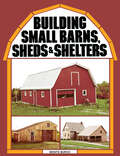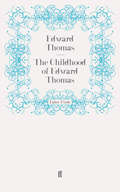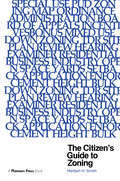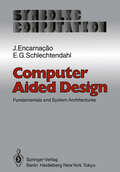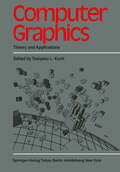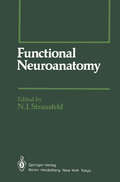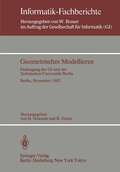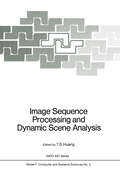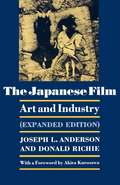- Table View
- List View
Broadcasting and Society 1918–1939 (Routledge Library Editions: Broadcasting #12)
by Mark PeggBroadcasting and Society (1983) examines the power of radio broadcasting as a medium of instant communication and entertainment. It is a detailed and critical examination of the social changes brought about by radio broadcasting in the crucial and formative stages between 1918 and 1939 – whether broadcasting was successful in keeping people better informed, in introducing wider interests, and its influence on social behaviour.
Broadcasting and Society 1918–1939 (Routledge Library Editions: Broadcasting #12)
by Mark PeggBroadcasting and Society (1983) examines the power of radio broadcasting as a medium of instant communication and entertainment. It is a detailed and critical examination of the social changes brought about by radio broadcasting in the crucial and formative stages between 1918 and 1939 – whether broadcasting was successful in keeping people better informed, in introducing wider interests, and its influence on social behaviour.
Building Small Barns, Sheds & Shelters
by Monte BurchBuild your own outbuildings and enjoy the space to do more of what you love. From simple toolsheds and animal shelters to smokehouses and low-cost barns, Monte Burch guides you through everything you need to know to make your small building projects a reality. Detailed blueprints, easy-to-follow instructions, and expert advice are suited to even the first-time builder. Discover how easy it is to create your own customized spaces that will allow your passions to grow.
Caravaggio
by Howard HibbardCaravaggio was one of the most important Italian painters of the 17th century. He was, in fact, the wellspring of Baroque painting. In Hibbard's words, Caravaggio's paintings "speak to us more personally and more poignantly than any others of the time". In this study, Howard Hibbard evaluates the work of Caravaggio: notorious as a painter-assassin, hailed by many as an original interpreter of the scriptures, a man whose exploration of nature has been likened to that of Galileo.
Caravaggio (Icon Editions Ser.)
by Howard HibbardCaravaggio was one of the most important Italian painters of the 17th century. He was, in fact, the wellspring of Baroque painting. In Hibbard's words, Caravaggio's paintings "speak to us more personally and more poignantly than any others of the time". In this study, Howard Hibbard evaluates the work of Caravaggio: notorious as a painter-assassin, hailed by many as an original interpreter of the scriptures, a man whose exploration of nature has been likened to that of Galileo.
The Childhood of Edward Thomas
by Edward ThomasKilled at Arras in 1917, Edward Thomas left behind him a short, vivid history of his own early life, covering the period from his birth to his entry into St Paul's. Though a fragment, in many senses it is far more: in the words of its author 'no less than an autobiography . . . an attempt to put down on paper what [this author] sees when he thinks of himself from 1878 to about 1895'. The Childhood of Edward Thomas was not published until 1938, over two decades after Thomas originally showed the manuscript to a publisher. Those eventual publishers, Faber & Faber, were building on their release two years earlier of Thomas's Collected Poems, for which he was becoming best known.This edition includes Edward Thomas's 'War Diary,' a record of the last three months of his life when, as an elderly - at thirty-eight - subaltern he fought among the misery of the trenches. To witness Thomas's childhood memoir and wartime diaries in such close proximity is to have a moving incarnation of his distinctive voice, its clarity and - even in war - its unfailing attention to his fellow-creatures.
Citizen's Guide to Zoning
by Herbert SmithFirst published in 1983. Routledge is an imprint of Taylor & Francis, an informa company. An easy-to-read book about zoning that cuts the jargon out but leaves the wisdom in. Smith explains the fundamental principles of zoning, how to develop zoning regulations, and the nuts and bolts of a zoning ordinance. He examines variances, zoning hearings, and frequent zoning problems.
Citizen's Guide to Zoning
by Herbert SmithFirst published in 1983. Routledge is an imprint of Taylor & Francis, an informa company. An easy-to-read book about zoning that cuts the jargon out but leaves the wisdom in. Smith explains the fundamental principles of zoning, how to develop zoning regulations, and the nuts and bolts of a zoning ordinance. He examines variances, zoning hearings, and frequent zoning problems.
City Landscape: A Contribution to the Council of Europe's European Campaign for Urban Renaissance
by A. B. Grove R. W. CresswellCity Landscape emerged from the City Landscape Conference held in Bath in 1981. The conference formed a contribution to the Council of Europe's campaign for Urban Renaissance and was organized in association with The Civic Trust, The Landscape Institute, The Royal Town Planning Institute, and The Society of Industrial Artists and Designers. The book is organized into four parts. Part One reviews the changes in urban landscape from early settlements to the establishment of more recent design philosophies, with emphasis on the need to develop the new opportunities now available to us. Part Two, still with strong inference to human aspects, takes the discussion into the fields of aesthetics, nature in the urban environment, and a creative approach to conservation and the establishment of urban woodlands. Part Three is an expression of confidence in modern design in the context of the urban environment, this extending into consideration of imaginative city environments by night. Part Four deals with education, participation, and management in the implementation of City Landscapes. It is hoped that those concerned with the creation and maintenance of open spaces in cities and towns will be inspired by this book in their efforts to achieve high standards of quality in their contribution to the urban environment.
Computer Aided Design: Fundamentals and System Architectures (Symbolic Computation)
by J. Encarnacao E. G. Schlechtendahl4 lation and optimization. These are essential constituents of the iterative process, leading to a feasible and, one hopes, optimal design. 1.3 Content of the Book In Chapter 2 we present briefly the history of CAD. The main components of CAD systems are identified, and their principal functions described. Economi cal and interdisciplinary aspects are discussed. Chapter 3 starts with a systems analysis of the design process. The notion of a process is introduced as a fundamental tool to describe activities like design as a whole, computer-aided design, program executions, terminal sessions etc. The environment and the resources which the environment must supply for the successful execution of any process are discussed. The problem of modelling the design objects in an abstract schema and the interrelation between the schema and the planning of the individual step in the design are analysed. Chapter 4 concentrates on the interfaces among the components of a CAD system, including the human operator. The problem of mapping an abstract schema onto the capabilities of various programming, command, or data de scription languages is described in detail. Emphasis is laid upon the resource aspect and its influence on the design of CAD systems. The concept of a CAD software machine is introduced, and rules for designing such machines are given.
Computer Graphics: Theory and Applications
by T. L. KuniiThis book is an extensive treatise on the most up-to-date advances in computer graphics technology and its applications. Both in business and industrial areas as well as in research and development, you will see in this book an incredible devel opment of new methods and tools for computer graphics. They play essential roles in enhancing the productivity and quality of human work through computer graph ics and applications. Extensive coverage of the diverse world of computer graphics is the privilege of this book, which is the Proceedings of InterGraphics '83. This was a truly interna tional computer graphics conference and exhibit, held in Tokyo, April 11-14, 1983, sponsored by the World Computer Grpphics Association (WCGA) and organized by the Japan Management Association (JMA) in coopera'tion' with ·~CM-SIGGRAPH. InterGraphics has over 15 thousands participants. This book consists of seven Chapters. The first two chapters are on the basics of computer graphics, and the remaining five chapters are dedicated to typical appli cation areas of computer graphics. Chapter 1 contains four papers on "graphics techniques". Techniques to generate jag free images, to simulate digital logic, to display free surfaces and to interact with 3 dimensional (3D) shaded graphics are presented. Chapter 2 covers "graphics standards and 3D models" in five papers. Two papers discuss the CORE standard and the GKS standard. Three papers de scribe various 3D models and their evaluations.
Cult Sci-Fi Movies: Discover the 10 Best Intergalactic, Astonishing, Far-Out, and Epic Cinema Classics
by Danny PearyCult Sci-Fi Movies is a collection of 10 essays that examine, dissect, defend, and exalt the greats of classic cult sci-fi films. Film geeks, cinema snobs, VHS collectors, and anyone else who likes their entertainment a little on the weird side will appreciate author Danny Peary&’s in-depth approach to their favorite sci-fi films ranging from Barbarella to Liquid Sky.
The De-Definition of Art (Phoenix Book Ser.)
by Harold Rosenberg"Like the great German critic Walter Benjamin, Rosenberg is a master of dialectics whose sense of art is continuous with his sense of society, and (also like Benjamin) bears no taint of compromised, out-of-work radicalism. Instead, his radicalism is very much at work, enabling him to spot and skewer fallacies, false logic and the camouflaged nudity that is a large part of the art emperor's new wardrobe. [The De-definition of Art] detects with great sensitivity the forces that are deflecting and pressuring art in the direction of esthetic and moral nullity."—Jack Kroll, Newsweek
A Documentary History of Art, Volume 2: Michelangelo and the Mannerists, The Baroque and the Eighteenth Century
by Elizabeth Gilmore HoltThe theory and practice of art underwent a number of fascinating changes between the sixteenth and the eighteenth centuries, changes which are clearly revealed in this unique collection of letters, journals, essays, and other writings by the artists and their contemporaries. In the poems of Michelangelo, the Dialogues of Carducho, or the Discourses of Sir Joshua Reynolds, one discovers the stylistic and philosophical concerns of the artist, while the record of Veronese's trial before the Holy Tribunal, the diary of Bernini's journey in France, the letters of Rubens and Poussin or biographical sketches of Rembrandt and Watteau reveal not only the personalities but also the conditions of the times.These basic and illuminating documents, now again available in paperback, provide an unparalleled opportunity for insight into the art and ideas of the periods the author discusses.
A Documentary History of Art, Volume 2: Michelangelo and the Mannerists, The Baroque and the Eighteenth Century
by Elizabeth Gilmore HoltThe theory and practice of art underwent a number of fascinating changes between the sixteenth and the eighteenth centuries, changes which are clearly revealed in this unique collection of letters, journals, essays, and other writings by the artists and their contemporaries. In the poems of Michelangelo, the Dialogues of Carducho, or the Discourses of Sir Joshua Reynolds, one discovers the stylistic and philosophical concerns of the artist, while the record of Veronese's trial before the Holy Tribunal, the diary of Bernini's journey in France, the letters of Rubens and Poussin or biographical sketches of Rembrandt and Watteau reveal not only the personalities but also the conditions of the times.These basic and illuminating documents, now again available in paperback, provide an unparalleled opportunity for insight into the art and ideas of the periods the author discusses.
Dynamic Economic Systems: A Post Keynesian Approach
by John M. BlattThe future of the Common Law judicial system in Hong Kong depends on the perceptions of it by Hong Kong's Chinese population, judicial developments prior to July 1, 1997, when Hong Kong passes from British to Chinese control, and the Basic Law. These critical issues are addressed in this book.
Dynamic Economic Systems: A Post Keynesian Approach
by John M. BlattThe future of the Common Law judicial system in Hong Kong depends on the perceptions of it by Hong Kong's Chinese population, judicial developments prior to July 1, 1997, when Hong Kong passes from British to Chinese control, and the Basic Law. These critical issues are addressed in this book.
Erforschung des Langzeitverhaltens von LD-Schlacken als Straßenbaustoff (Forschungsberichte des Landes Nordrhein-Westfalen #3170)
by Günter BlunkFarm Buildings: in England and Wales (Routledge Revivals)
by John WoodfordeFirst published in 1983, Farm Buildings gives a fascinating account of what has been happening in and around farm buildings since medieval times, and describes their structure, their function and their style. This is followed by a long section in which sixty-eight representative types of Welsh and English farm buildings are commented on by the author and illustrated by John Penoyre. John Woodforde emphasizes that just as people increasingly enjoy looking at old farm buildings, so too some farmers are coming to appreciate them with a new eye, noting that they possess in their yards assets whose value is greater in several ways than they used to think. This book will be of interest to students of architecture, history and agriculture.
Farm Buildings: in England and Wales (Routledge Revivals)
by John WoodfordeFirst published in 1983, Farm Buildings gives a fascinating account of what has been happening in and around farm buildings since medieval times, and describes their structure, their function and their style. This is followed by a long section in which sixty-eight representative types of Welsh and English farm buildings are commented on by the author and illustrated by John Penoyre. John Woodforde emphasizes that just as people increasingly enjoy looking at old farm buildings, so too some farmers are coming to appreciate them with a new eye, noting that they possess in their yards assets whose value is greater in several ways than they used to think. This book will be of interest to students of architecture, history and agriculture.
Functional Neuroanatomy (Springer Series in Experimental Entomology)
by M. E. Adams J. S. Altman J. P. Bacon U. K. Bassemir C. A. Bishop E. Buchner H. Bülthoff S. D. Carlson Chi Che F. DelComyn H. Duve M. Eckert T.R.J. Flanagan G. Geiger C. H. Hackney B. Hengstenberg R. Hengstenberg N. Klemm D. R. Nässel M. O Shea W. A. Ribi R.L. Saint Marie H. S. Seyan P. T. Speck N. J. Strausfeld A. Thorpe J. Ude D. W. WohlersThe "functional" in the title of this book not only reflects my personal bias about neuroanatomy in brain research, it is also the gist of many chapters which describe sophisticated ways to resolve structures and interpret them as dynamic entities. Examples are: the visualization of functionally identified brain areas or neurons by activity staining or intracellular dye-iontophoresis; the resolution of synaptic connections between physiologically identified nerve cells; and the biochemical identification of specific neurons (their peptides and transmitters) by histo- and immunocytochemistry. I personally view the nervous system as an organ whose parts, continuously exchanging messages, arrive at their decisions by the cooperative phenome non of consensus and debate. This view is, admittedly, based on my own ex perience of looking at myriads of nerve cells and their connections rather than studying animal behaviour or theorizing. Numerous structural studies have demonstrated that interneurons in the brain must receive hundreds of thousands of synapses. Many neurons receive inputs from several different sensory areas: each input conveys a message about the external world and possibly also about past events which are stored within the central nervous system. Whether an interneuron responds to a certain combination of inputs may be, literally, a matter of debate whose outcome is decided at the post synaptic membrane. A nerve cell responding to an overriding command is possibly a rare event.
Geometrisches Modellieren: Fachtagung der GI und der Technischen Universität Berlin Berlin, 24.–26. November 1982 (Informatik-Fachberichte #65)
by H. Nowacki R. GnatzGlued To The Box: Television Criticism From The Observer, 1979-82
by Clive JamesThe final instalment in Clive James’s collections of TV criticism in The Observer including pieces originally published between 1979 and 1982. Adding to an already unforgettable collection of comic brilliance, fans of Visions Before Midnight and The Crystal Bucket will not be disappointed.
Image Sequence Processing and Dynamic Scene Analysis (NATO ASI Subseries F: #2)
by T. S. HuangThis volume contains the proceedings of the NATO Advanced Study Institute on "Image Sequence Processing and Dynamic Scene Analysis" held 21 June - 2 July, 1982 in Hotel Maritim, Braunlage/Harz, Federal Republic of Germany. The organizing eommittee of the institute consists of T.S. Huang (Director), H.G. Musmann (Co Director), H.H. Nagel (Consultant), and C.E. Liedtke and W. Geuen (Local 'arrangement). This Institute was devoted to the rapidly emerging field of image sequence processing and dynamic scene analysis which has man! important applications in cluding target tracking, television bandwidth compression, highway traffic moni toring, and analysis of heart wall motion for medical diagnosis. The lectures and discussions in this Institute fell into three overlapping categories: Motion estimation; pattern recognition and artificial intelligence techniques in dynamic scene analysis; and, applications. 1) Motion estimation - One of the most important problems in image sequence analysis and dynamic scene analysis is displacement and motion estimation. For example, in interframe coding using temporal DPCM, displacement estimation and compensation can improve efficiency significantly. Also, estimated motion parameters can be powerful cues in target segmentation, detection, and classification. In this Institute, a number of recently developed techniques for displacement and motion estimation were discussed.
The Japanese Film: Art and Industry
by Joseph L. Anderson Donald RichieTracing the development of the Japanese cinema from 1896 (when the first Kinetoscope was imported) through the golden ages of film in Japan up to today, this work reveals the once flourishing film industry and the continuing unique art of the Japanese film. Now back in print with updated sections, major revaluations, a comprehensive international bibliography, and an exceptional collection of 168 stills ranging over eight decades, this book remains the unchallenged reference for all who seek a broad understanding of the aesthetic, historical, and economic elements of motion pictures from Japan.

